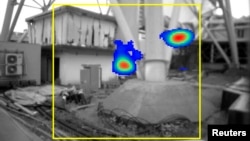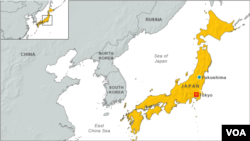An ongoing leak at Japan's troubled Fukushima nuclear power plant is allowing dangerously radioactive water to escape.
The Tokyo Electric Power Company [TEPCO] said Tuesday it is working to identify how the water began leaking from a steel storage tank, which contains water used to cool the plant's melted reactors. Company officials said at least 300 tons of radioactive water have leaked.
TEPCO says there has been no significant change in radiation levels outside the plant. It said the puddle of leaked water is emitting a radiation dose of 100 millisieverts per hour, though, a level considered harmful to humans.
TEPCO spokesman Masayuki Ono apologized for the leak at a press conference in Tokyo. "It can be said that we found a radiation level strong enough to give someone a five-year dose of radiation within one hour," he said.
The operator is working to clean up the puddle. It does not believe that any of the water from the storage tank has leaked into the nearby Pacific Ocean.
The company acknowledged earlier this month that leaked water from elsewhere in the plant, however, has been seeping into the sea. Shortly after this, the Japanese government stepped up its role in the plant's cleanup.
The plant has been running out of room to store radioactive water used to cool the reactors, which melted down following a massive earthquake and tsunami in March 2011 that shut off the plant's power and cooling systems.
It was the world's worst nuclear disaster since the 1986 Chernobyl accident in the Soviet Union. No one is reported to have died as a direct result of the Fukushima disaster, though tens of thousands are unable to return to their homes surrounding the facility.
The Tokyo Electric Power Company [TEPCO] said Tuesday it is working to identify how the water began leaking from a steel storage tank, which contains water used to cool the plant's melted reactors. Company officials said at least 300 tons of radioactive water have leaked.
TEPCO says there has been no significant change in radiation levels outside the plant. It said the puddle of leaked water is emitting a radiation dose of 100 millisieverts per hour, though, a level considered harmful to humans.
TEPCO spokesman Masayuki Ono apologized for the leak at a press conference in Tokyo. "It can be said that we found a radiation level strong enough to give someone a five-year dose of radiation within one hour," he said.
The operator is working to clean up the puddle. It does not believe that any of the water from the storage tank has leaked into the nearby Pacific Ocean.
The company acknowledged earlier this month that leaked water from elsewhere in the plant, however, has been seeping into the sea. Shortly after this, the Japanese government stepped up its role in the plant's cleanup.
The plant has been running out of room to store radioactive water used to cool the reactors, which melted down following a massive earthquake and tsunami in March 2011 that shut off the plant's power and cooling systems.
It was the world's worst nuclear disaster since the 1986 Chernobyl accident in the Soviet Union. No one is reported to have died as a direct result of the Fukushima disaster, though tens of thousands are unable to return to their homes surrounding the facility.









